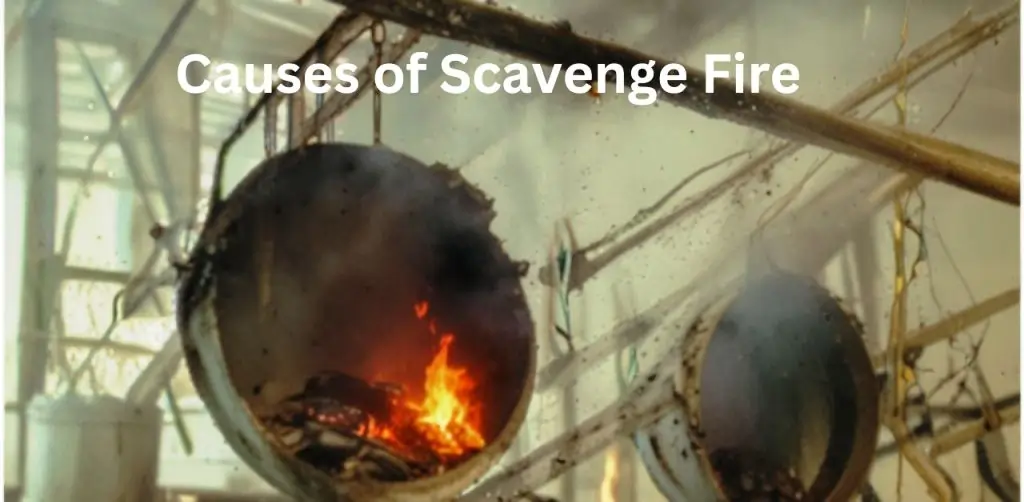Causes of Scavenge Fire
Scavenge fires are among the most dangerous incidents in a ship’s engine room, often leading to severe accidents and operational disruptions. Known for their destructive potential, these fires have historically been the cause of numerous maritime emergencies.
To effectively combat scavenge fires, it is crucial to understand their root causes and the appropriate actions to take when they occur. We cover all you need to know about scavenging fires in this post, including their causes, warning indicators, and ways to avoid them.Equip yourself with the knowledge to safeguard your vessel and crew against this formidable hazard.
What Are Scavenge Fires?
Scavenge fires are a dangerous occurrence in marine engines, happening within the scavenge space. This space is an integral part of the engine, facilitating the removal of exhaust gases and the introduction of fresh air into the cylinders for efficient combustion.
Definition and Occurrence
A scavenge fire happens when oil, unburnt fuel, or other flammable residues in the scavenge space ignite due to excessive heat or sparks. These fires are typically associated with two-stroke marine diesel engines, where high temperatures and mechanical wear can lead to the accumulation of such residues.
The Role of the Scavenge Space
The scavenge space serves as a vital area in the engine’s operation. Positioned between the cylinder liner and the crankcase, it ensures the smooth passage of fresh air required for combustion while expelling exhaust gases. However, the accumulation of deposits like carbon, oil mist, or unburnt fuel in this area creates a potential fire hazard if not adequately maintained.
Understanding the mechanics and vulnerabilities of the scavenge space is key to preventing scavenge fires and ensuring safe engine operations.
The 6 Common Causes of Scavenge Fires
Scavenge fires often result from a combination of mechanical issues and operational inefficiencies. Below are the six primary causes that lead to this dangerous situation:
1. Excessive Liner Wear
Excessive wear on the cylinder liner disrupts the engine’s efficiency and leads to heat buildup in critical areas. This wear allows hot gases to escape, potentially igniting oil deposits or fuel residues in the scavenge space.
2. Worn-Out or Loose Piston Rings
Piston rings play a crucial role in maintaining the seal between the piston and cylinder liner. When these rings are worn out or become loose, oil leaks into the scavenge space, increasing the likelihood of overheating and subsequent fires.
3. Broken or Seized Piston Rings
A broken or seized piston ring disrupts combustion, causing unburnt fuel and oil residues to accumulate in the scavenge space. The increased friction and reduced sealing lead to high temperatures, making ignition of these residues more probable.
4. Dirty Scavenge Space
The accumulation of carbon, oil mist, and other residues in the scavenge space creates a flammable environment. When subjected to pressure and heat during operation, these deposits can ignite, leading to a scavenge fire.
5. Poor Combustion
Leaking fuel valves or improper timing can result in incomplete combustion, leaving unburnt fuel to settle in the scavenge space. This unburnt fuel acts as a fuel source for fires when exposed to high temperatures or sparks.
6. Insufficient or Excess Cylinder Lubrication
Adequate lubrication is crucial to prevent overheating and minimize friction. Insufficient lubrication leads to excessive heat, while excess lubrication can cause oil deposits in the scavenge space. Both situations elevate the likelihood of a fire occurring.
Understanding these causes is critical to maintaining safe engine operations and preventing scavenge fires, which pose a significant risk to vessel safety. Regular maintenance, monitoring, and adherence to operational best practices can help mitigate these risks effectively.
Signs of a Scavenge Fire
Recognizing the early signs of a scavenge fire can be crucial in preventing further damage to the engine and ensuring timely intervention. Below are the key indicators to watch for during engine operation:
1. Rising Scavenge Temperature
An increase in scavenge temperature is one of the first signs of a potential fire. This is often caused by excessive heat buildup due to poor combustion, worn-out parts, or insufficient lubrication.
2. Turbocharger Surging
Turbocharger surging, or irregular fluctuations in the turbo speed, may occur when there is a buildup of combustion gases or unburnt fuel. This could indicate abnormal conditions within the engine, possibly caused by a scavenge fire.
3. High Exhaust Temperature
A spike in exhaust temperature can signal incomplete combustion or a fire in the scavenge space. This temperature increase may be a result of fuel residues igniting in the scavenge area.
4. Reduced Engine Power and RPM
A scavenge fire can cause the engine to lose power, resulting in a drop in RPM. This reduction is due to impaired combustion efficiency and the engine’s struggle to maintain consistent operation under fire-related stress.
5. Smoke from Scavenge Drains
Smoke coming from the scavenge drains is a clear indicator of a fire in the scavenge space. It signifies that flammable materials are burning within the engine, possibly threatening further damage.
6. Paint Blistering on Scavenge Doors
Blistering or bubbling paint on the scavenge doors is another visual clue of elevated temperatures due to a fire. Prolonged heat exposure can cause the paint to degrade, signaling a potentially hazardous situation in the engine room.
Being vigilant and recognizing these signs early can help in taking prompt corrective action to avoid severe damage to the engine and ensure the safety of the crew and vessel.
Immediate Actions to Take During a Scavenge Fire
A scavenge fire requires prompt and calculated responses to minimize damage and ensure safety. Below are the critical steps to follow:
1. Reduce Engine Speed
Lowering the engine speed helps to limit the heat generation and prevent further escalation of the fire. It also stabilizes engine conditions, making it easier to manage the situation.
2. Cut Fuel to the Affected Cylinders
Immediately stop the fuel supply to the cylinders affected by the fire. This action eliminates the source of combustion, reducing the intensity of the fire.
3. Increase Lubrication to the Affected Areas
Boosting lubrication in the affected cylinders helps to prevent further overheating and protects the mechanical parts from excessive damage during the incident.
4. Close Scavenge Drains
Seal the scavenge drains to contain the fire within the scavenge space. This step prevents flames from spreading to other areas of the engine, mitigating the risk of widespread damage.
These immediate actions form a critical response plan to address scavenge fires effectively and protect the engine from severe damage.
Methods for Extinguishing Scavenge Fires
Effectively extinguishing a scavenge fire requires the use of appropriate fire suppression techniques. Below are the most common and effective methods used to tackle scavenge fires in marine engines:
1. Steam
Steam is a widely used method for suppressing scavenge fires. By introducing steam into the scavenge space, oxygen levels are reduced, suffocating the fire. This method is highly effective in controlling fires without causing significant damage to engine components.
2. Water Mist
Water mist systems are another efficient way to extinguish scavenge fires. The fine mist lowers the temperature in the affected area and cools the surrounding surfaces, effectively stopping the fire’s progression. Additionally, water mist reduces the likelihood of reignition by addressing residual heat.
3. CO2 Systems
Carbon dioxide (CO2) systems are specifically designed to combat fires in confined spaces like the scavenging area. CO2 removes oxygen from the environment, effectively cutting off the fire’s main source of fuel. This method is quick, effective, and minimizes the risk of collateral damage to sensitive engine parts.
Each of these techniques plays a vital role in fire management on ships, ensuring safety and preserving engine functionality.
Prevention Tips to Avoid Scavenge Fires
Preventing scavenge fires is essential for ensuring the safety and efficiency of marine engines. Implementing the following measures can significantly reduce the risk of such fires:
1. Routine Maintenance and Inspections
Regularly scheduled maintenance and thorough inspections of engine components, including liners, piston rings, and turbochargers, are critical. Identifying and addressing wear and tear early prevents the conditions that lead to scavenge fires.
2. Ensuring Proper Lubrication Levels
Maintaining optimal lubrication is vital to reduce friction and overheating. Insufficient lubrication can cause excessive heat, while excessive lubrication can lead to residue buildup in the scavenge space, increasing fire risk.
3. Regular Cleaning of the Scavenge Space
Regular cleaning of the scavenge space helps prevent the buildup of carbon deposits, oil residue, and unburnt fuel. A clean scavenge space minimizes the chance of ignition due to residual deposits.
4. Monitoring Fuel Valve Condition and Timing
Properly functioning fuel valves and accurate timing are essential for efficient combustion. Faulty valves or improper timing can cause unburnt fuel to collect in the scavenge space, creating a potential fire hazard.
By adhering to these prevention tips, ship operators can minimize the likelihood of scavenge fires and maintain safer engine operations.
FAQs on Causes of Scavenge Fire
Q: What causes a scavenge fire?
A: Scavenge fires often happen when cylinder oil and fuel residues build up in the scavenge space.
Q: What is the first step to take during a scavenge fire?
A: Notify the bridge immediately and stop the engine as soon as it is safe to do so.
Q: How can a scavenge fire be extinguished?
A: Fires in the scavenge space can be put out using steam, water mist, or CO2.
Q: What sensor is used to detect a fire?
A: Smoke detectors with optical or electrochemical sensors are commonly used.
Conclusion
Scavenge fires are a serious hazard in marine engines, often caused by factors such as excessive liner wear, faulty piston rings, and dirty scavenge spaces. Recognizing the warning signs, such as rising temperatures and smoke from drains, can help address the issue promptly and minimize damage.
Prevention is the most effective strategy to combat scavenge fires. Routine maintenance, ensuring proper lubrication, regular cleaning of the scavenge space, and monitoring fuel valve performance are crucial steps to enhance engine safety and operational efficiency.
By staying proactive with inspections and adhering to preventive measures, you can protect your marine engine from the costly and dangerous consequences of scavenge fires. Prioritizing engine health not only ensures smooth operations but also safeguards crew and cargo, keeping your voyage secure and efficient.

